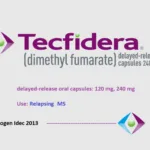Plegridy is an injectable medication used to treat multiple sclerosis (MS), a disease in which inflammation affects the protective layer surrounding nerves (demyelination) as well as the nerves themselves.
It is used primarily in individuals with relapsing-remitting MS, a kind of MS in which the patient experiences symptom flare-ups (relapses) in between times of healing (remissions).
| Plegridy Class | Interferon Beta 1a |
| FDA-approved indications | Relapsing Multiple Sclerosis |
| You may also like to read: |
Plegridy Uses:
Plegridy (Interferon Beta 1a) is used primarily to treat the relapsing types of MS (Multiple Sclerosis). Relapsing MS is one with episodes of exacerbations and a disease-free period.
The exact cause of Multiple Sclerosis is unknown. MS is a disease that affects the brain and spinal cord.
There are periodic “exacerbations” in people with relapsing forms of MS (e.g. weakness in the legs or arms, blurred vision, or loss of control of bowel or bladder function). They are accompanied by rest periods. Recovery can be complete or partial.
Plegridy can also be used to treat persons who have clinically isolated syndrome (CIS). The first episode of MS-like symptoms with CIS lasts at least 24 hours.
Inflammation or demyelination is the cause of the episode (loss of the protective covering on your nerve cells). MS may or may not develop as a result of CIS.
Additionally, this medication can also be used to treat people with secondary progressive MS (SPMS), a type of MS that causes relapses. The medication helps SPMS patients have fewer relapses and brain lesions.
Plegridy (Interferon Beta 1a) Uses | |
| FDA-approved indications | Relapsing Multiple Sclerosis |
| Non-FDA-approved Indications | Clinically isolated syndrome (CIS) |
| Secondary Progressive Multiple Sclerosis | |
| You may also like to read: |
How to use Plegridy (Interferon beta 1a):
Plegridy is available as a prefilled pen and a syringe. Both the pen and the syringe come in two forms:
- 125 mcg per 0.5 ml, and
- the starter pack containing 94 mcg per 0.5 ml
Both the pen and the syringe are single-use injections/ pens.
Plegridy is typically administered subcutaneously into the skin of the abdomen, thigh, or upper arms. It can also be administered intramuscularly.
It is administered once every two weeks just like you inject insulin. A medical professional might instruct you on how to take the drug correctly on your own.
Read all drug guides or instruction sheets and adhere to all instructions on your prescription label. On occasion, your doctor could adjust your dosage.
Only prepare an injection when you’re ready to administer it. If the medication has picked up particles or changed colors, do not use it.
| You may also like to read: |
Plegridy Dose in Relapsing MS:
Plegridy can only be given intramuscularly (IM) or subcutaneously (SC).
Subcutaneous Administration Of Plegirdy
The FDA-recommended dosage for PLEGRIDY is 125 micrograms subcutaneously given every 14 days after the first titration.
Patients may alternate injection locations between the abdomen, upper arm back, and thigh. The dosing schedule as recommended by the FDA-prescribing leaflet is given here [Ref]:
Dose # | Time | Dose (micrograms) | Syringe label |
| Dose 1 | Day 1 | 63 | Orange |
| Dose 2 | Day 15 | 94 | Blue |
| Dose 3 | Day 29 and every 14 days thereafter | 125 (full dose) | Grey |
Intramuscular Administration Of Plegridy
The IM dose is the same as the subcutaneous dose. Patients may alternate between injecting into their left and right thighs.
Dose | Time | Amount (micrograms) | Titration clip |
| Dose 1 | Day 1 | 63 | yellow |
| Dose 2 | Day 15 | 94 | purple |
| Dose 3 | Day 29 and thereafter every 15th day | 125 (full dose) | No clip needed |
| You may also like to read: |
Side effects of Plegridy (Interferon Beta 1a):
It’s important to remember that your doctor suggested this medicine because they thought it would be more beneficial to you than harmful. Numerous users of this medication claim no discernible side effects.
It should be avoided in patients who are allergic to the drug or have had a past history of severe hypersensitivity reactions to the drug.
Fever and flu-like symptoms:
Plegridy can induce fever and flu-like symptoms like chills and headaches. Gradually raising the dosage should also help lessen these effects.
Contact your doctor if you experience a persistent fever while taking this medicine.
Blood issues:
The number of platelets and neutrophils (a type of white blood cell that aids in the fight against infection) may drop after using this drug (which helps your blood clot).
To monitor this, your doctor will perform blood tests.
Contact your doctor right away if you get any infection symptoms, such as fever, chills, or a sore throat, as well as any unusual bleeding or bruises.
Thyroid issues:
Some people who take this medication see changes in the way their thyroids function.
Increased sweating, a fast heartbeat, weight loss without a change in food or exercise routine, or emotional or worrisome feelings are signs of these changes. If you have these symptoms, consult a doctor.
Heart problems:
This medicine may aggravate heart disease symptoms. If you have a cardiac problem such as arrhythmia, angina, or congestive heart failure, talk to your doctor about how this medicine may impact your medical condition.
If you begin to experience signs of a heart condition, such as breathlessness, chest pain, an increased heart rate, or swollen ankles, call your physician as soon as you can.
Seizures:
There have been sporadic instances of interferons causing seizures. Higher doses of this medicine are more likely to cause seizures.
Consult your doctor if you have a history of epilepsy or other illnesses that raise your risk of seizures.
| You may also like to read: |
Mechanism of action of Plegridy (Interferon Beta 1a MOA):
Peginterferon beta-1a does not have a well-defined mechanism of action in multiple sclerosis (MS).
Peginterferon beta-1a binds to the type I interferon receptor on the surface of cells, which causes a series of intracellular processes that control the expression of interferon-responsive genes.
Peginterferon beta-1a may have biological effects such as up-regulation of anti-inflammatory cytokines (such as IL-4, IL-10, and IL-27) and down-regulation of pro-inflammatory cytokines (such as IL-2, IL-12, IFN-γ, and TNF-α), as well as preventing activated T cells from crossing the blood-brain barrier. However, other mechanisms may also be involved [Ref].
Plegridy (Interferon Beta 1a) MOA | |
| Up-regulation of Cytokines |
|
| Downregulation of Cytokines |
|
Some side notes for Plegridy
- To get the most out of this drug, take it frequently. Use it at the same time and on the same day of the week to help you remember.
- Switch up the injection place every time, to prevent skin damage under the skin,
- Investigate the injection location. Observe the injection site for 2 hours to see whether there is any reaction.
- When you remember that you missed a dose, take it right away. Use this drug no more than two days in a row.




